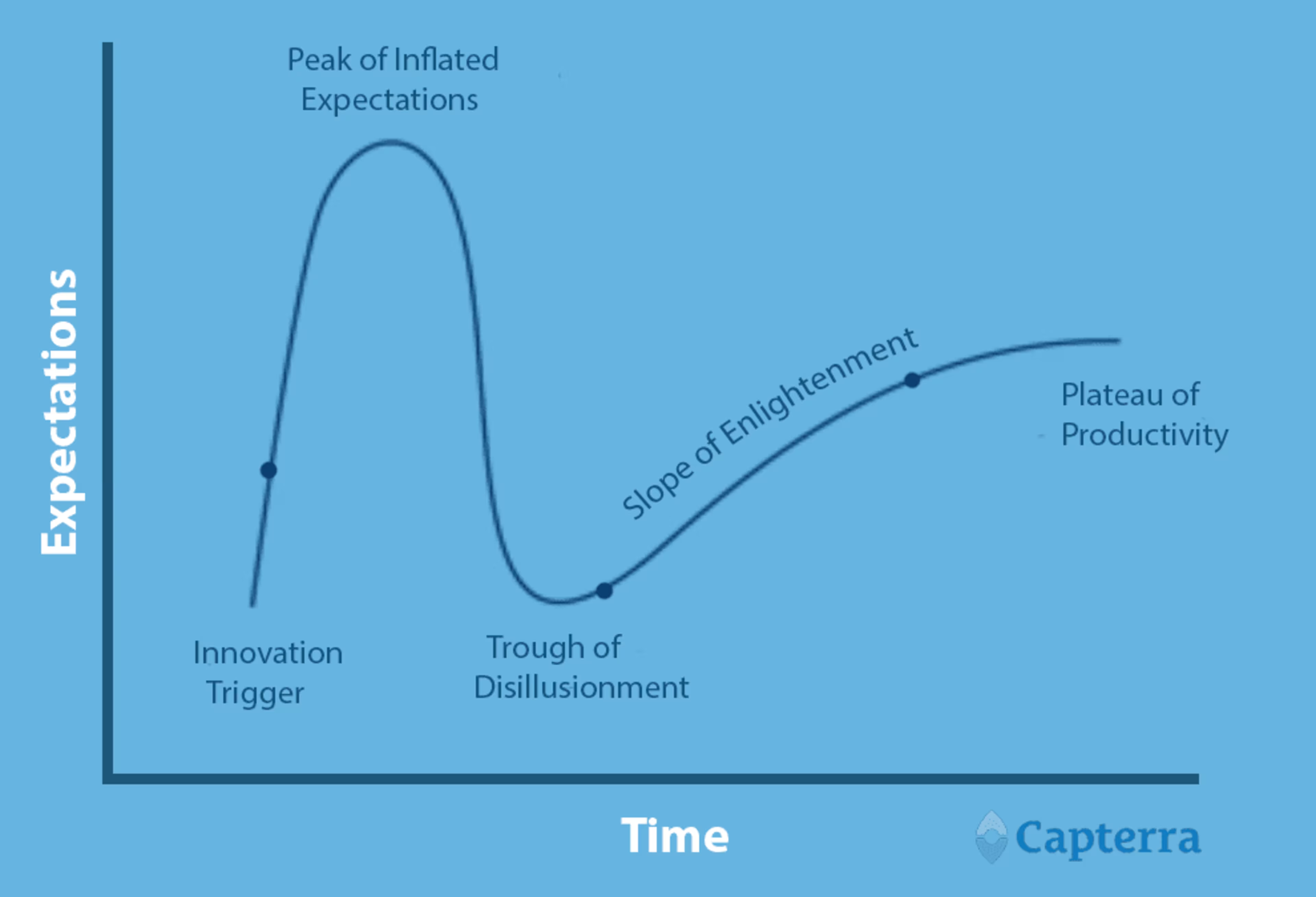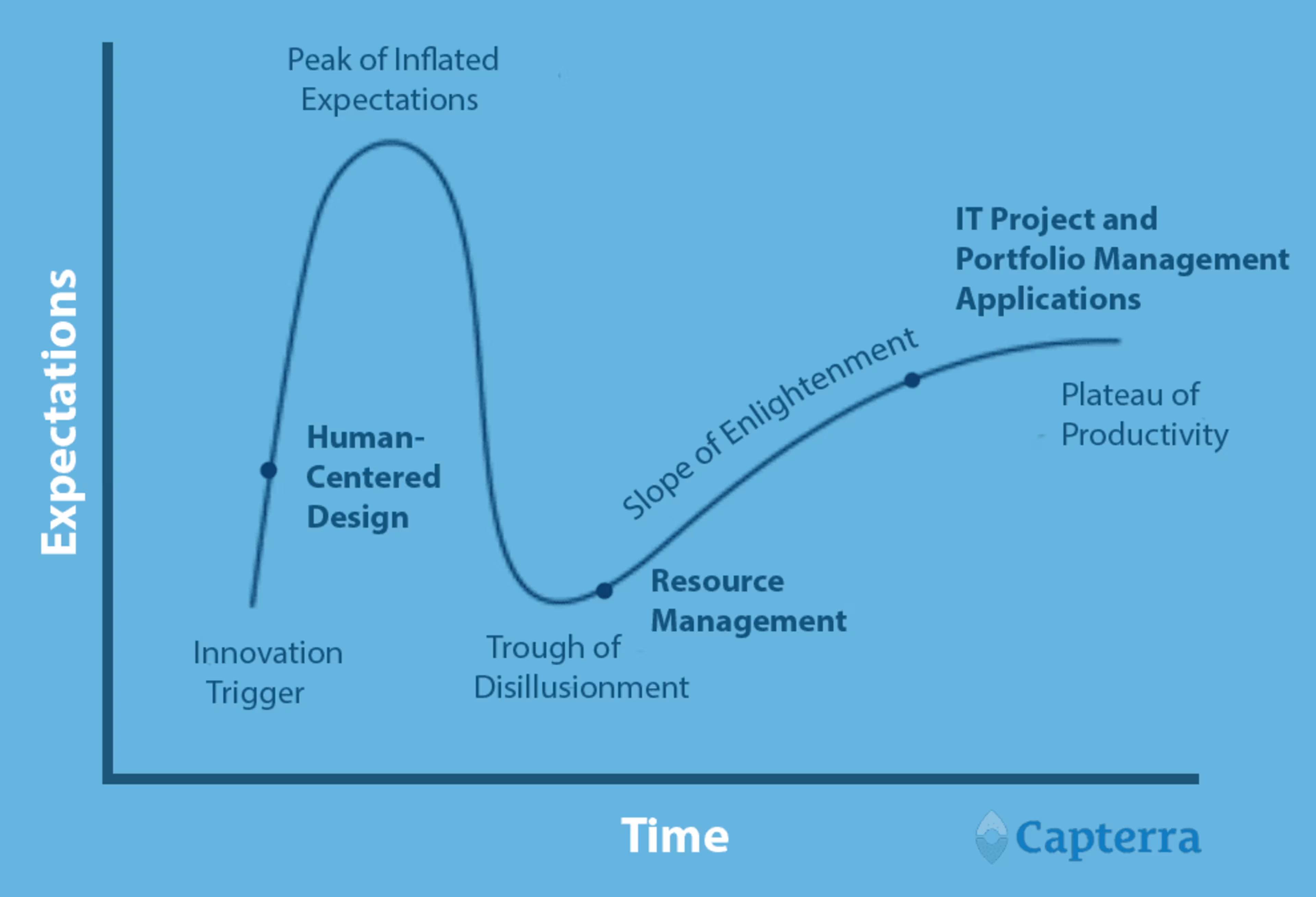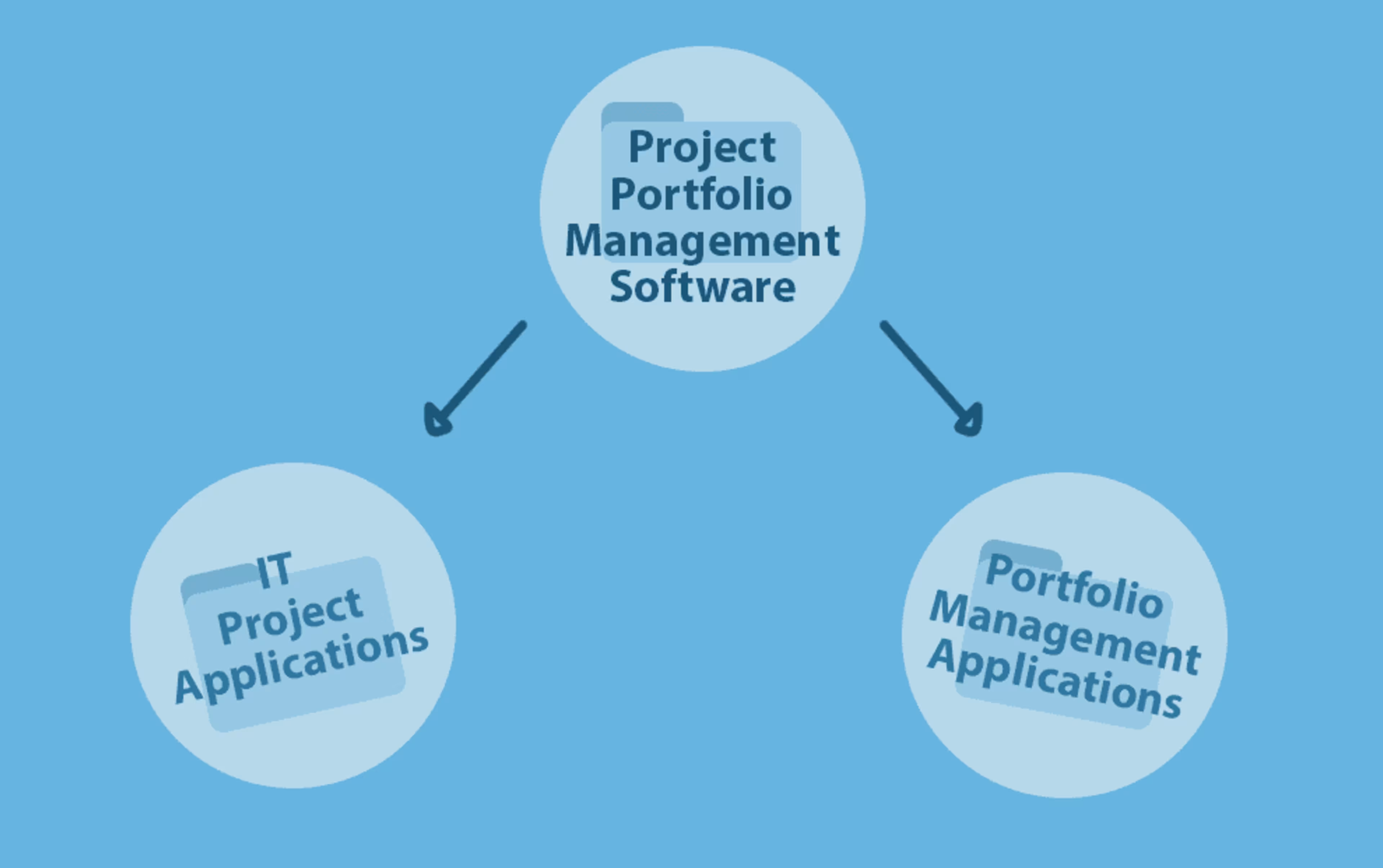Have you heard of business Agile yet?
If not, don't worry—you're not that far behind. It's only started to catch on in early 2017, but the concept is spreading faster than contempt for the new credit card chip readers that only sometimes work.
Here's the gist: the Agile philosophy (essentially continuous delivery and improvement) is so infectious that it's spreading from IT to all parts of the business world, and adoption only grows faster with the growing presence of AI and emphasis on emotional intelligence.
And this isn't a rote spread of methods such as Scrum and Lean—it's a mindset shift for business leaders big and small.
Gartner first put “business Agile" on their project and portfolio management Hype Cycle in July 2016 (Gartner research is available to clients only). By 2017, business Agile grew to an adolescent trend, implying that it will run through adoption and development very quickly across the business world.
The Gartner Hype Cycle is extremely useful for enterprise-level businesses, but what about small businesses, who are leading the trend of business Agile?
Project managers, I'm excited to present you with the small business Hype Cycle. This iteration of the Hype Cycle provides project managers working for _any-_sized company insight into what's to come for their industry, along with a checklist of to-dos to implement these insights and get ahead of the curve.

What is the Hype Cycle?
One of Gartner's flagship products is the Hype Cycle, which looks something like this:

Gartner tracks new technology and trends over time and maps them to each of the five points on the cycle itself.
During the innovation trigger, a potentially awesome new technology comes out, and people (if they're aware of it) are excited for its possibilities. While the tech or trend often isn't usable (or available commercially), it tends to garner lots of press—and not necessarily adoption. Its viability has yet to be proven.
Following the innovation trigger, some companies may have tried out this new way of thinking, hardware, or software. Publicity is making the product more popular... or causing companies to lose interest because of bad press. In the peak of inflated expectations, some companies adopt, but most are still too nervous from the failure stories to jump in.
And they'll feel validated in the immediate fallout. Interest wanes over time as industry leaders emerge, shaking products that are more hype than helpful. During the trough of disillusionment, new technology and trends enter a depression, and are forced to lean back on their early adopters.
What they're waiting for is the slope of enlightenment, when the benefits of those innovations have become far clearer to the paying market. New iterations of the product start to emerge—and they're much better than what was first available at the innovation trigger.
While conservative companies might hold off during the slope of enlightenment, they might finally be convinced to try the product or idea during the plateau of productivity. Why? Mainstream adoption has finally started to take hold. According to Gartner, you know a product is in the plateau of productivity when "The technology's broad market applicability and relevance are clearly paying off."
Why should project managers care?
While super interesting for tech nerds like me, the Hype Cycle can, at first, appear to be "Hmm, that's cool" as opposed to "Wow, that's helpful!" And when you're in a niche industry like project management, it's easy to think that a lot of what appears in the Hype Cycle doesn't apply to you.
Except there isn't one Hype Cycle. There are multiple.
There's even one specific to project management.
For example, the latest project management Hype Cycle shows that the PMP is in the trough of disillusionment, which would explain why many companies no longer require it for employment.
It also shows that enterprise Agile frameworks are still more hype than clearly helpful, and that, while still growing in adoption, "traditional IT project management will be used for systems of record, with other project management methodologies being used for systems of differentiation and innovation." In other words, traditional is retiring. Agile, along with a few B-level forms of project management, will continue to replace traditional as the dominant project management method in years to come.
Insights from the Hype Cycle can affect how you conduct your business, and even how you shape your own career.
With the growth of business Agile, it's a classic battle between the strength of gargantuan industry conglomerates and small, quick business that can adopt change rapidly. With insight into the Hype Cycle, small business—and project managers—can compete with the giants.
Read more about business Agile.
The Small Business Hype Cycle: Project Management
Keeping the benefits of learning the Hype Cycle close to our hearts, I have developed an abridged Hype Cycle for my area of expertise: project management in small businesses.
Limited to only three points along the cycle, I decided to focus on one trend in the innovation trigger (who doesn't love new project management tools and trends?), one in the trough of disillusionment (where are we starting to see things fall apart), and one in the slope of enlightenment (what's not so bad after all?).

1. The innovation trigger: Human-centered design
Human-centered design is an old idea turned anew, one where people are at the center of design (and project) needs instead of requirements. With a new emphasis on "customer-first" design and Agile project management, it's no surprise that human-centered design has reentered project management's marketplace of ideas.
Here's the philosophy: language and requirements aren't great at communicating design features.
For example, imagine that you want to design the next Facebook, but you're not a developer.
You hire a contractor—someone much better at programming than you—and you're required to describe what your idea of Facebook looks like. It doesn't exist yet, so you can't reference photographs, and since you're describing the idea from ideation, you might not know exactly what the login screen should look like—and what's worse, your "vision" of what the website should look like gets garbled over time. The poor contractor is only doing what you ask, but she isn't able to access the image in your mind.
Guess you're out of luck.
That's where human-centered design comes in. The contractor focuses on why you want to create "the next Facebook" and uses ethnographic and anthropological methods to get a feel for you, specifically, and the behavioral drive for hiring them to create this design.
Human-centered design flips the burden of requirements onto the contractor instead of the client.
If you're an Agilist, you are probably nodding along and reminding yourself of one of the Manifesto's core values, "customer collaboration over contract negotiation."
As Waterfall and traditional project management methods wane in adoption, interpretations of what Agile is and how to apply it will innovate in and of itself. Human-centered design is part of Agile version 2.0.
Taking advantage of human-centered design is difficult. Clients and contractors don't necessarily speak the same "language," especially as technological expectations and limitations have inflated to an unsustainable pace for human minds. Understanding human-centered design requires understanding the human condition, which can turn philosophical instead of practical very quickly.
Getting this innovation right will take time and practice.
To do:
Read this Wired article that gives a great overview of how to start off with human centered design.
Practice human-centered design techniques on non-essential, non-critical projects before rolling it out. As of now, I would recommend trying this only on integrated Agile or DevOps teams because of its added complexity.
Document your findings and iterate. Human-centered approaches at this scale have yet to really spark best practices lists, so see what works for you and your team and become a thought leader on the topic.
2. The trough of disillusionment: Resource management

"They're people!"
Dave West, the CEO of Scrum.org, is completely fed up with the idea of "resource management," and rightly so. Resource management is a term that is old and corporate.
According to Gartner, the formal definition of resource management is:
Resource management leverages both proven and emerging techniques to dynamically optimize the use of available human resources to achieve business objectives. Techniques that improve individual productivity and team performance are within the scope of resource management, as are techniques to manage resource demand.
Ugh, talk about being a cog in the wheel.
If you're wondering how resource management became popular in the first place, think about manufacturing—or even just the traditional business environment. People need to be used most effectively to get things done. There is entire field of resource management software (often a feature in project management software, as well) dedicated to "optimizing" how your people work.
Dave West has it right, though. They're people. Software cannot account for variability in the human condition.
Companies want an absolute: "Perfect Employee Management," one where people are intrinsically motivated to use their time in ideally portioned periods to benefit the business—with a genuine, I-love-my-job smile wide across their face.
What's happened is that quantitative metrics have forced businesses to lose sight of that end goal. Managers are focused on clocked hours, outputs, and raw revenue. That's not people focused. That's business focused.
Oh hey, it's Agile again, reminding us that project managers should care about "individuals and interactions over processes and tools."
Sure, resource management tools can help, but only if the leadership, techniques, and nuanced workforce understanding already exists.
To do:
Invest in management training. Soft skills are easy to learn and tough to apply, so make sure your most people-facing managers (yourself included) have the emotional intelligence to be able to best understand and then best use their people.
Give your teams responsibility for outcomes, a reasonable due date, and then leave them alone. Let them best allocate their time and then hold them accountable.
Root out "resources," or people who you're only keeping around because they're good at their job. If someone makes work miserable for most people, overall productivity is likely less than what it should be.
3. The slope of enlightenment: IT project and portfolio management applications

IT project and portfolio management—or IT PPM—has an air of sagacity to it. It's been the backbone of project management since before the PMP was created, and it is the very foundation of project management as an industry.
IT project and portfolio management applications embody a subset of project portfolio management software. Standbys include Microsoft Project, Clarizen, and Liquidplanner.
These heavy tools were designed at conception to manage IT project against unmovable resources such as time, people, and money. Over the past 30 years, they've changed to account for widespread internet adoption, policy changes, SaaS implementation, security concerns, and everything in between. With so much history, these tools have proven that they're worth their investment (but only when they're used correctly).
The idea that one tool can do everything is a dated concept. Think about it: if you look at social media, you're not going to get all the benefits of Twitter, Facebook, and LinkedIn in just one platform; there's value to them being separate for the end user.
The same is true of business software. As project portfolio managers find their span of control seeping out of IT and into other departments such as HR and marketing, they will need to learn more than just one core system to be able to manage projects effectively. After all, project portfolio managers in a business Agile environment are involved with a project from conception to sales.
Because of added complexity and the need for greater business agility, project managers will increasingly need to rely on supplemental plugins and third-party integrations—from Adobe to Zenefits—to be able to do their jobs effectively. The implication, then, is that traditional project managers need to make room for new workstreams, and adapt those work paradigms to their existing tools.
To do:
Lower your expectations that one solution can take care of all of your IT PPM's needs—instead, invest in learning common integrated apps like Salesforce or QuickBooks (if this sounds like nascent IoT to you, you're right on the money).
Implement casual conversation tools such as Slack and its alternatives to ease conversation pains between applications.
Prepare for vendors to conglomerate as these traditional tools try to become more Agile.
More project management trends that are over or under hyped?
What was your gut reaction to human-centered design, resource management's positioning, and the change in IT PPM tools? Was there anything here that you strongly agreed or disagreed with? What was missing?
Let's continue the conversation below.
What will you read next?
The Top 5 IT Project Portfolio Management Software For Usability
4 Groundbreaking Project Portfolio Management Predictions for 2022